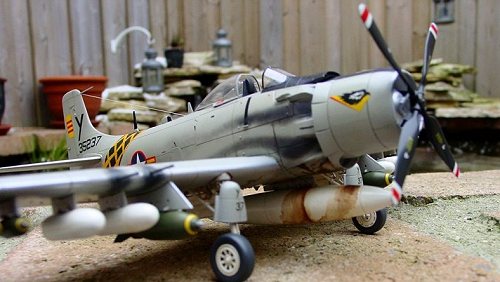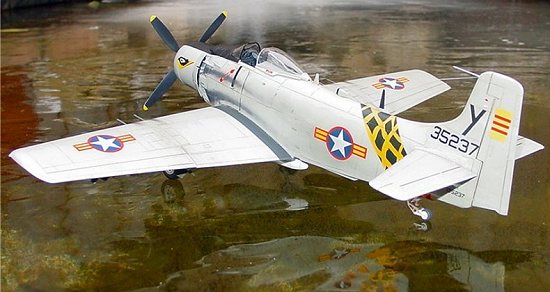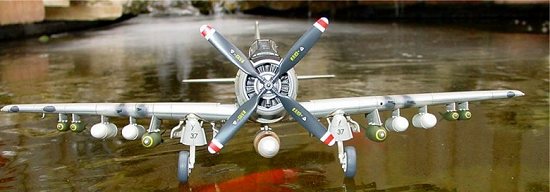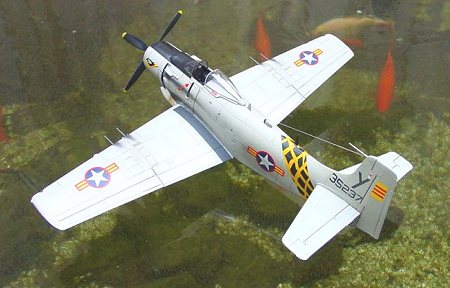
Tamiya 1/48 A-1H Skyraider
|
KIT: |
Tamiya 1/48 A-1H Skyraider |
|
KIT # |
58073 |
|
PRICE: |
$25.99 |
|
DECALS: |
See Review |
|
REVIEWER: |
|
|
NOTES: |

|
HISTORY |
Conceived in 1945, it was not until the 60s that the Spad, as the Douglas AD-6 Skyraider was affectionately nicknamed, came into it’s own.
Rugged, fairly easily maintained, and above all potent, it proved to be difficult to design a better plane to replace it. When in the early 60s the Skyraider was being phased out of the U.S. Navy front-line squadrons the war in Vietnam began to unfold and there the Spad proved to be an ideal platform for close air support. It’s relatively long loitering time and awesome arsenal made it a popular plane to those in need of firepower on the ground, and frequently the Skyraider was asked as preferred relief when the air was thick with angry lead. The Spad found a new lease on life and except the USN now the USAF began using Skyraiders in Vietnam as well.
As the war gradually escalated and the VNAF (South Vietnamese Air Force) was starting to flap it’s wings, the Skyraider was a logical choice to replace the ageing and metal-fatigued ex-French AF F8F-1Bs of the VNAF’s 1st Fighter Squadron, later redesignated 514th Fighter Squadron. 25 were initially delivered after they were zero-timed at the USN rework facility. They were as good as new. The 514th had four flights, each sporting different colorful fuselage bands, with the squadron commander’s aircraft having a fuselage band consisting of all four flight’s bands combined.
|
THE KIT |
 In the sturdy box you will find everything you need to make
any US Navy AD-6/A-1H. Optional wheel hubs (closed or spoked), open or closed
cowl flaps, opened or closed airbrakes, positionable canopy, positionable wing
flaps, and two types of tail wheels. Weapons include 2000 lb. bombs, HVAR
rockets, two wing and one centerline fuel tanks, 250 lb. bombs and rocket pods.
There are decal options for planes of VA-52, VA-25 and VA-176. The instruction
sheet is quite clear and gives detailed painting instructions for the parts.
Tamiya paint numbers are given.
In the sturdy box you will find everything you need to make
any US Navy AD-6/A-1H. Optional wheel hubs (closed or spoked), open or closed
cowl flaps, opened or closed airbrakes, positionable canopy, positionable wing
flaps, and two types of tail wheels. Weapons include 2000 lb. bombs, HVAR
rockets, two wing and one centerline fuel tanks, 250 lb. bombs and rocket pods.
There are decal options for planes of VA-52, VA-25 and VA-176. The instruction
sheet is quite clear and gives detailed painting instructions for the parts.
Tamiya paint numbers are given.
The level of details is very very nice and panel lines are finely engraved. The molds are all very crisp and the canopy is among the clearest I have ever seen. Very nifty is Tamiya approach with the propeller shaft and centerline fuel tank: tight rubber holders are provided which when placed (without glue) inside the engine and centerline fuel tank allow for the prop and tank to be attached using no glue.
|
CONSTRUCTION |
Cockpit
Construction starts with the cockpit assembly. I never use after-market stuff, and the kit parts to me look good enough. There’s a decal for the instrument panel, but I opted to paint the instruments on my model. The gunsight is a clear part. Everything fit very well.
Fuselage
 Next the fuselage halves are glued together, with the
cockpit assembly and tail wheel well installed in one of them beforehand. I
sanded the joining areas of the fuselage halves lightly prior to gluing them
together to get as little seam as possible. Again, fit was good and no filler
was needed to get a nice seam line, just some light sanding with 1200 grit and a
better-quality nail-file with three different kinds of grit on them. These
nail-files with a polishing surface on one side and two grits on the other are
also great for removing scratches from canopies.
Next the fuselage halves are glued together, with the
cockpit assembly and tail wheel well installed in one of them beforehand. I
sanded the joining areas of the fuselage halves lightly prior to gluing them
together to get as little seam as possible. Again, fit was good and no filler
was needed to get a nice seam line, just some light sanding with 1200 grit and a
better-quality nail-file with three different kinds of grit on them. These
nail-files with a polishing surface on one side and two grits on the other are
also great for removing scratches from canopies.
Engine
Next step is the engine. I airbrushed the cowling inside white (and a little front portion on the glue fuselage) and engine parts and when they were dry I assembled them. On my subject there’s a silver leading edge extending a few millimeters inside the cowling. I should have airbrushes that when the cowling was still empty, but I kind of forgot to look ahead on that one. More on how I resolved that later. Just paint the cowling as complete as possible before assembly, as doing it when the cowling and engine are assembled is more difficult. Again, all parts only needed very minor clean-up to fit very well.
Boring kit? Not at all. This was my FIRST Tamiya kit and it was like loosing virginity all over again. These highly engineered kits solve old troubles and create new ones….
Another mistake I made was to attach the pre-painted exhaust stacks to the engine / cowling assembly and then followed the instructions and glued the whole assembly to the fuselage. This would later interfere with airbrushing the base color. Leave it off and attach it when the model is completely painted. THEN attach the assembly and touch-up the joint lines.
Wings
 The wings assembled while the above stuff was drying,
after pre-painting the wheel well inside white (Revell 04) and a wash of burnt
umber. The closure of the wheel wells in the wing has to be seen to be believed.
It fits very well and leaves no gap. Not even minimal. The breakdown is such
that the well doors are automatically in the correct angle. Great engineering.
At this stage I painted the wing overall Humbrol 129, followed by masking and
airbrushing the silver leading edges and wing walkways with Tamiya German Gray.
This was done for the horizontal stabilizers at the same time to minimize
airbrush cleaning time and chemicals.
The wings assembled while the above stuff was drying,
after pre-painting the wheel well inside white (Revell 04) and a wash of burnt
umber. The closure of the wheel wells in the wing has to be seen to be believed.
It fits very well and leaves no gap. Not even minimal. The breakdown is such
that the well doors are automatically in the correct angle. Great engineering.
At this stage I painted the wing overall Humbrol 129, followed by masking and
airbrushing the silver leading edges and wing walkways with Tamiya German Gray.
This was done for the horizontal stabilizers at the same time to minimize
airbrush cleaning time and chemicals.
Landing Gear
Again: wow! Very nicely done, great fit and very convincing appearance. I always pre-paint as much as possible, and this was also done for the gear.
The main wheels are easily masked with Tamiya tape because the rim for the inner wheel hub stands out far enough to make it possible to put the tape on the edge of the rim, so extending the hub outward with the tape so to speak. I pre-painted the wheels Revell 04 and when masked sprayed the tires Tamiya German Gray. The outer hubs are separate parts and were installed after painting the tires.
Flaps
These can be positioned opened or closed and fit like a glove. The actuators need some cleanup though. Not much, but it stood out compared with the quality of the rest of the kit. I left mine closed (normal position when on the ground).
Air brakes
 Guess what? Great fit on these as well. I closed the left
and right brakes for my Skyraider. The edges of the cover line up with the
well’s edges just fine and look convincing. The ventral dive break… now here’s
where you have to make some choices. On some Skyraiders, it was wired shut. If
it was not wired shut, and the engine was shut down, the ventral brake would
open up a little bit due to the lack of hydraulic pressure. Since my model is
representing a static sitting duck I decided to show that little feature. I
simply inserted a little piece of sprue in to the brake bay and glued the brake
hinges to the fuselage, with a tiny drop of superglue on the piece of sprue to
give it more strength. Looks just like in photos!
Guess what? Great fit on these as well. I closed the left
and right brakes for my Skyraider. The edges of the cover line up with the
well’s edges just fine and look convincing. The ventral dive break… now here’s
where you have to make some choices. On some Skyraiders, it was wired shut. If
it was not wired shut, and the engine was shut down, the ventral brake would
open up a little bit due to the lack of hydraulic pressure. Since my model is
representing a static sitting duck I decided to show that little feature. I
simply inserted a little piece of sprue in to the brake bay and glued the brake
hinges to the fuselage, with a tiny drop of superglue on the piece of sprue to
give it more strength. Looks just like in photos!
Tail wheel and Arrestor hook
VNAF Skyraiders did not have the arrestor hook installed so I left it off. The tail wheel can be built as the solid rubber or the inflated version. VNAF Skyraiders mostly had the solid rubber variety. Fit is good.
I pre-painted the gun barrels, hood-rail, prop (mix of Tamiya German gray with black), pylons (with silver leading edges on the two main pylons) and weapons and set them aside to attach them when the plane was completely assembled.
|
CAMOUFLAGE & MARKINGS |
Tanh Phong flight belonging to the 514th Fighter Squadron was my choice for this kit. Cutting Edge and CAM decals both did a sheet depicting several of Vietnamese aircraft with colorful fuselage bands, but not this one. I only know of one photo where this fuselage band can be seen. I decided to go for that one and airbrush it on.
 First I did the Revell Lufthansa Yellow base for the
fuselage band. I had made a template from decal sheet cover which was identical
in size and shape to the fuselage bands from the Cutting Edge sheet. I placed
that on the fuselage and masked the to-be-yellow area with Tamiya tape to
conform to the template, and airbrushed the area after I wrapped the fuselage in
toilet paper and tape so that no gray was exposed. When this was dry I cut the
shapes for the red flames out of Tamiya tape, placed them where I thought they
should go and airbrushed them red.
First I did the Revell Lufthansa Yellow base for the
fuselage band. I had made a template from decal sheet cover which was identical
in size and shape to the fuselage bands from the Cutting Edge sheet. I placed
that on the fuselage and masked the to-be-yellow area with Tamiya tape to
conform to the template, and airbrushed the area after I wrapped the fuselage in
toilet paper and tape so that no gray was exposed. When this was dry I cut the
shapes for the red flames out of Tamiya tape, placed them where I thought they
should go and airbrushed them red.
Now came the hard part. Masking off the dark blue puffs of smoke. This was a very fiddly undertaking and it took me at least an hour and a half for each side. I kept changing the position of the pieces of tape until I was satisfied. I used Tamiya Midnight Blue with some flat base added to it to prevent the paint from creeping under any loose masking tape that I had missed, and applied very light coats until everything was solid midnight blue.
The Tamiya paint dries quickly, and soon the Ta-Da moment was there for me. I removed all masking and was very pleased with the result. The Cutting Edge and CAM sheet’s subjects are quite unique, but this was even more unique. ;o)
When all was dry I glued the wing and horizontal stabilizers to the fuselage and filled very minor gaps with Crystal Clear and wood glue. Last I repaired the gray finish where needed and added the windscreen, which was already pre-painted Tamiya flat black. Again, I touched up the seam of the windscreen.
 The whole thing was then given a coat of Humbrol Gloss.
The serial number was combined from the three different serials provided with
the kit. Since there was no 2 (for BuNo 135237) in any of the serials, I
mirrored a 5 and it worked beautifully. National insignia and cowling badge came
from the Cutting Edge sheet. The decals were quite stiff and even after several
applications of Micro Set and Micro Sol they wouldn’t snuggle in to the panel
lines completely. The “Y” tail code was an “X” from a Matchbox 1/72 Phantom
FGR.2 cut and trimmed. The “37” on the landing gear doors should read “237” but
I didn’t have the right decals in the spares box. If anyone has two “2”s in
modern RAF style numbers (1/72) I offer myself to help them get rid of those ;o)
The whole thing was then given a coat of Humbrol Gloss.
The serial number was combined from the three different serials provided with
the kit. Since there was no 2 (for BuNo 135237) in any of the serials, I
mirrored a 5 and it worked beautifully. National insignia and cowling badge came
from the Cutting Edge sheet. The decals were quite stiff and even after several
applications of Micro Set and Micro Sol they wouldn’t snuggle in to the panel
lines completely. The “Y” tail code was an “X” from a Matchbox 1/72 Phantom
FGR.2 cut and trimmed. The “37” on the landing gear doors should read “237” but
I didn’t have the right decals in the spares box. If anyone has two “2”s in
modern RAF style numbers (1/72) I offer myself to help them get rid of those ;o)
After putting on the decals it got another coat of Humbrol Gloss. Weathering was done with burnt umber in various dilutions. The exhaust dirt was airbrushed with Tamiya German Gray again, as were the stains near the guns. To make the wing look really dirty I wiped the first three attempts of the gun-smudge in airflow direction with a very wet tissue soaked in IsoPropy-lAlcohol (or rubbing alcohol as many people call it in the U.S.)
|
FINAL CONSTRUCTION |
If you do an early VNAF Skyraider, make sure to check whether it has the red navigation light on top of the vertical stabilizer and Yankee extraction system (135237 had neither). And if it had spoked or solid wheel hubs (both come with the Tamiya kit). You also need to check the antennae lay-out of the Skyraider of your choice. The one on top of the fuselage band in my model was not included in the kit, I made it out of styrene sheet.
I snagged the Mk 117s from Tamiya’s A-1J kit.
The oil spill on the fuel tank was created by allowing repeated flows of moderately thinned burnt umber followed by repeated flows of heavily thinned drops of the same until the effect pleased me, wiping off any excess from the lower surface of the tank in the direction of what the air flow would be. I used a fairly small brush and a capillary pipette as an applicator. In all, I had great fun with this one and I am ready to start another VNAF Skyraider, A-1J this time, in SEA camouflage.
|
CONCLUSIONS |
This model for me is truly my latest and greatest (considering my modeling skills). I can recommend this kit to anyone. There are no difficult areas at all.
January 2003
If you would like your product reviewed fairly and quickly, please contact me or see other details in the Note to Contributors.